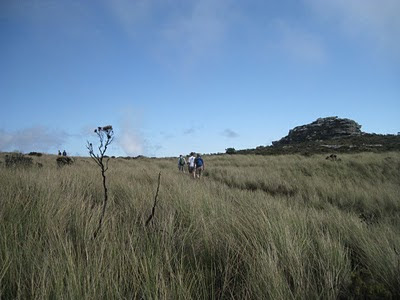The weather gods gave us a cool day. A soft misty morning is just what you need when you’re going to walk from Hout Bay up Myburgh’s Ravine to the top of Table Mountain and then all the way over the mountain back to the city. Add to that a marching master who said it could be done in six hours and any small mercy is welcome.
 The last weekend of January is Red Disa Weekend. While we had been eating Christmas duck and gallivanting on holiday, the disa show had been in pre-production. All over Table Mountain’s cool, mossy corners their tightly rolled red buds had been quietly pushing out into the filtered light of ravines and forests and rocky overhangs. Now here we were, at the end of January, arriving for the show.
The last weekend of January is Red Disa Weekend. While we had been eating Christmas duck and gallivanting on holiday, the disa show had been in pre-production. All over Table Mountain’s cool, mossy corners their tightly rolled red buds had been quietly pushing out into the filtered light of ravines and forests and rocky overhangs. Now here we were, at the end of January, arriving for the show.  As we climbed up Myburgh’s Ravine the yellowwood forest, lichen covered rocks and walls of ferns surrounded us with greenness. And then. We came around a corner and there was the Red Disa show, mid-performance, in full swing. Red velvet petals unfurled in full glory, scattered in the greenness. Not just any red, but a deep scarlet satin-red that glowed in the green light of the ravine. The orchids danced on their long thin stalks like delicate dancers. Here was the chorus line of summer.
As we climbed up Myburgh’s Ravine the yellowwood forest, lichen covered rocks and walls of ferns surrounded us with greenness. And then. We came around a corner and there was the Red Disa show, mid-performance, in full swing. Red velvet petals unfurled in full glory, scattered in the greenness. Not just any red, but a deep scarlet satin-red that glowed in the green light of the ravine. The orchids danced on their long thin stalks like delicate dancers. Here was the chorus line of summer.At the top of the ravine the light, even that of a misty day, was suddenly bright and glaring. Ripe yellow summer grass waved in the wind and clouds tumbled onto the plateau. It was like going from a rain forest to the grass plains of the Serengeti in a few steps.
But there was more red to be seen. That same exact shade of deep red dotted the landscape. It was the crassula and it had more than the colour of its flowers in common with the red disa. They are both deeply involved with the same butterfly. In this love triangle, the butterfly is called Mountain Pride and she is a beauty. She has a thing for a disa and a crassula. She pollinates both. When she lands on the flowers to drink the sweet nectar from deep inside the flower, the pollen sticks to her sweet little feet and off she goes. Long live the disa and the crassula, thanks to her.
 Off we went too. We had a six-hour deadline to meet. Do not think for one second that the top of Table Mountain is flat. When this chunk of earth pushed up from the depths zillions of years ago, it did so in huge shoves. So here we were now, walking over the hills and valleys on top of the mountain. It was like turning the pages in a kiddies’ pop-up book.
Off we went too. We had a six-hour deadline to meet. Do not think for one second that the top of Table Mountain is flat. When this chunk of earth pushed up from the depths zillions of years ago, it did so in huge shoves. So here we were now, walking over the hills and valleys on top of the mountain. It was like turning the pages in a kiddies’ pop-up book. Suddenly the huge vertical 100m-high rock wall of Oudekraal Ravine appeared ahead of us. Then Muizenberg and False Bay popped up. Corridor, Slangolie Buttress, Woody Ravine. Who needs to write poetry when these are the names of the bits of mountain in your own backyard.
Suddenly the huge vertical 100m-high rock wall of Oudekraal Ravine appeared ahead of us. Then Muizenberg and False Bay popped up. Corridor, Slangolie Buttress, Woody Ravine. Who needs to write poetry when these are the names of the bits of mountain in your own backyard.By the time we headed down Kasteelpoort, the weather gods had moved on to another assignment. Now the heat was upon us. We trudged along the pipetrack towards Kloofnek, hot and dry. Plus we got to the end in just over six hours, thanks to the herding skills of the marching master. And thanks to the chorus line of Red Disas that still played in my head.









 For a long time I thought Crassula was just the name of a street in the suburb of Devils Peak. But no, it is not. Crassula is a red thing of beauty that flowers in bright blotches on the driest slopes of Table Mountain in the most arid month of the year: January.
For a long time I thought Crassula was just the name of a street in the suburb of Devils Peak. But no, it is not. Crassula is a red thing of beauty that flowers in bright blotches on the driest slopes of Table Mountain in the most arid month of the year: January.


